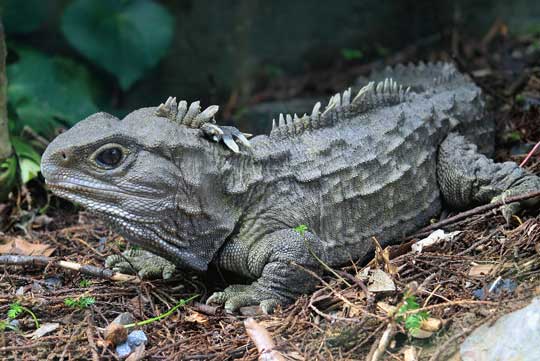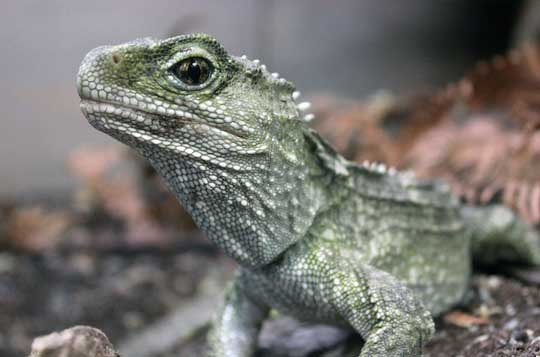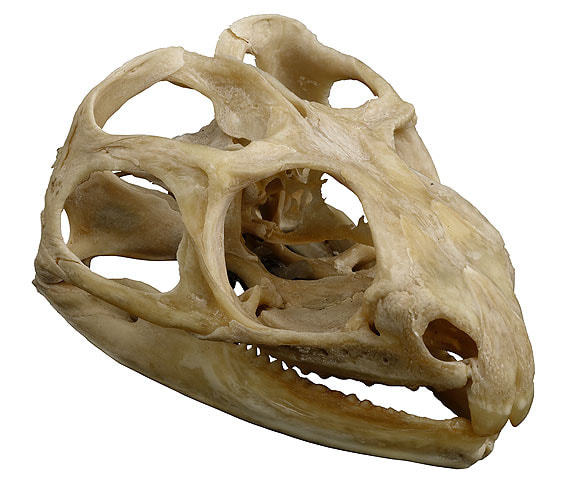|
Way back in 1995, Trish and I had a special opportunity to visit New Zealand with a group of about thirty other science teachers. One of the places we visited was the Aukland Zoo. What a spectacular place! I was thrilled to see so many animals that I had never seen before other than in photographs. But what I most anticipated seeing was the tuatara. At first glance the tuatara looks like a lizard, like a rather bland version of some kind of iguana. But I knew that this creature was much, much more than that. The tuatara is, in fact, one of the most unusual reptiles alive today. Read on to learn more... What the heck is a Tuatara? Tuataras look like lizards, but they aren't lizards. Lizards and snakes belong in an order called Squamata. The tuatara is in a completely different order all by itself, called Rhynchocephalia. That's a mouthful: rink-oh-ceph-ale-ya. Only one species of Rhynchocephalia (the tuatara) survives today, and it only lives in New Zealand. But there was a time, millions of years ago when dinosaurs roamed the earth, when there were many species, even some bizarre marine species. The Rhynchocephalia were once probably as abundant as lizards are today. Why is the tuatara NOT a lizard? Hmm... where to begin... Amazing facts about the Tuatara Back in 1831, a British zoologist by the name of John Edward Gray discovered the tuatara (yes, I know—he didn't really discover the species... the native Maori were aware of it long before then). He sent a skeleton to the British Museum, and it was misidentified as a lizard. It wasn't until 1867 that another scientist named Albert Günther examined the skeleton and realized that it actually had features seen in crocodiles, turtles, and birds! So Günther proposed creating the order Rhynchocephalia just for this creature. So we've known for 152 years that the tuatara is not a lizard! If the tuatara isn't a lizard, is it a dinosaur? Nope, not a dinosaur either, although they were abundant while dinosaurs were around. First, to fully appreciate how unique the tuatara is, let's consider this: The huge group of animals called “amniote vertebrates” includes mammals (6,495 species), turtles (341 species), birds (15,845 species), crocodylians (25 species), lizards and snakes (10,078 species). And then there's the Rhynchocephalia... with ONE species, the tuatara! Let's look at what makes tuataras so unique. First, they have a third eye. What? A third eye? Well, kind of. This third eye is situated just where you would expect it to be—on top of the forehead. It's actually known as a parietal eye. It really does have a lens and a retina, but it is more primitive than the tuatara's regular eyes, and can mostly just detect the presence or absence of light. The exact purpose of the eye is not fully understood, but it is thought to help the tuatara judge the time of day and the season, which would help it with thermoregulation (maintaining its body temperature). I should point out that tuataras are not the only animals to have parietal eyes. They are found in some burrowing lizards, some frogs, and some fish, including sharks. But the parietal eyes of the tuatara are more developed than these others. The photo below points out where the parietal eye is on a tuatara. One of the most distinctive features of tuataras (that sets them apart from other reptiles) is that they have a second row of upper teeth. When they close their mouths, the one row of teeth on the lower jaw fits nicely between the two rows on the upper jaw. Actually, they are not even real teeth at all. Unlike other reptiles, their teeth are not separate structures. Instead, they are simply sharp projections of the jaw bone. Therefore, the "teeth" are not replaced when they break off. Because of this, the "teeth" gradually get worn down as the tuatara grows older. So, old tuataras have to switch to eating only soft prey like earthworms and grubs. Eventually they have to chew their food with nothing more than smooth jaw bones. Too bad old tuataras can't get dentures, huh? Check out the tuatara skull below. You can see the rows of "teeth" on the sides. You can also see the beak-like front teeth (lizards don't have those), as well as the strange arches behind the eyes (lizards don't have those either). There are other aspects of this skull that separates tuataras from lizards, but I have to be honest—they are beyond my ability to accurately describe them! Speaking of those "teeth," tuataras do not chew like lizards chew. Instead of chewing up and down, the jaws of tuataras have a forward-and-backward sawing motion, slicing food like a steak knife. This apparently works well—tuataras can chew through chiton and bone. It allows them to eat tougher prey. In fact, they are known to decapitate birds (headless bird bodies are often found near tuatara nests). Tuataras are extremely tolerant of cold (for a reptile). I seem to remember a Gary Larson cartoon with a crocodile on the witness stand angrily telling the prosecutor, “Well, of course I did it in cold blood, you idiot! I’m a reptile!” But in reality, most reptiles become very lethargic in colder temperatures (making it so that the crocodile would be incapable of committing the crime in question). But not so the tuatara. They have a unique type of hemoglobin in their blood that allow them to be active at temperatures only a few degrees above freezing. Not only that, but they can hold their breath for up to an hour! This slow metabolism makes it so that tuataras have really slow development and really long lifespans. I mean really long. It takes a tuatara a whopping 14 years to reach sexual maturity, and it takes 35 year for them to be fully grown. Once mature, it takes the females up to three years to produce eggs with yolk. And THEN it takes twelve to fifteen months from copulation to hatching! During that time, it takes up to seven months just to form the egg shells. Yeesh. Not in much of a hurry, are they? Check out this video about hatchling tuataras. So, if it takes 35 years to grow up, how long can these things live? Astoundingly, the oldest tuatara that we know of is Henry. Henry the tuatara lives in the Southland Museum in Invercargill, New Zealand. Henry became a celebrity when he finally decided to mate with a female at the age of 111 (like I said, not in a hurry). That was in 2009, so now Henry is 121 years old. Henry had the honor of meeting Prince Harry at the age of 118 (that was the age of Henry, not Prince Harry). So, the tuatara deserves a place in the. F.A.H.O.F. (Fabuloso Animal Hall of Fame). FUN FACT: The word fabuloso comes from the Latin fābulōsus (which means fabulous, great, wonderful). It is somewhat difficult to trace the origins of its use in the English language because it is also used in several other languages (including Portuguese and Spanish). But from what I can tell, it is used to add a particular stylistic flair to the word fabulous (making it more flamboyant and expressive). Oddly enough, it is also the name of a multi-purpose cleaner used for cleaning bathrooms, tile floors, and such. Anyway, fabuloso is another way to say awesome! Photo Credits:
Tuatara #1 - San Diego Zoo Tuatara #2 - somaholiday/Flickr via AustralianGeographic.com Parietal eye - c00lbeans69 via Imgur Tuatara skull - Museum of New Zealand Henry with Prince Harry - Tim Rooke/REX Shutterstock via The Telegraph
0 Comments
Leave a Reply. |
Stan's Cogitations
Everyone needs a creative outlet. That's why I write. Archives
July 2024
|






 RSS Feed
RSS Feed